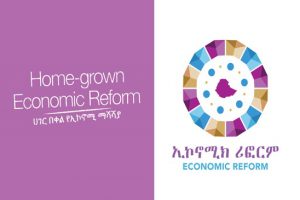
Water resource manag- ement in agriculture is a critical contributor to the economic and social development of Ethiopia. In this regard, irrigation, if successful, could signify a cornerstone of the agricultural development of the country, contributing to the economy and potentially moving up a million households into food security.
It is clear that the performance of the Ethiopian economy as a whole is highly correlated with the agricultural sector and contributes approximately 75 percent to the National Gross Domestic Product (GDP), and accounts for 70 percent of export earnings. The largest share of export value comes from cash crops such as coffee and sesame.
According to Dr. Mandefro Nigussie, General Director of Ethiopian Institute of Agricultural Research, EIR, Ethiopia though has ample agricultural potential to produce various types of crops, it still relies heavily on importing wheat to satisfy its growing populations need. To end this, the Institute has commenced different initiatives to make the country self-sufficient in wheat production over the next four years. The recent performance of the agricultural sector is promising.
The initiative is being implemented in Awash, Wabeshebelle and Omo basins, in areas where wheat production was not previously practiced. “Through employing various methods specifically irrigation, intensification, acid soil management and vertisol method we can definitely ensure and satisfy the needs of the society at large. Mechanization could also boost Ethiopian wheat production and provide youth with new job opportunities. Currently, lowland wheat production was successfully demonstrated in Awash and Omo basins,” he added.
Mentioning that Ethiopia’s agriculture commonly relies on rainfall with limited use of water resources for irrigation he said that, like many countries, the nation should have to develop its own spectrum of solutions to fulfill the needs of its people.
“Ethiopia has a greater opportunity in water led development, but if it is to capture its full potential, it needs to address the critical challenges in the planning, design, delivery, and maintenance of its irrigation systems,” he added.
As to him, the nation can chart a practical path of initiatives that will allow it to support the scale-up of its irrigated agricultural sector, the growth of smallholder farmers, and the lead to the transition of its pastoralist communities to food and water security.
Nigussie Abebe Irrigation Researcher at Werer Agricultural Research Institute said that to augment the production of wheat, in addition to better access to improved seeds and recommended inputs, better agronomic practices are needed. Scaling the use of irrigation would certainly increase wheat yields.
The majority of Ethiopia’s 4.2 million wheat farmers cultivate this cereal on an average of 1.2-hectare holdings, with three quarters produced in Arsi, Bale, and Shewa regions. Most prepare the land and sow following traditional farming practices with draft animal power, equipment, and few inputs, dependent on erratic rainfall without complementary irrigation. Yields have doubled over the last 15 years and reached 2.7 tons per hectare according to the latest agricultural statistics, but are still far from the yield potential.
Ali Ibrahim Ali is among the beneficiaries of the Awash River Basin Irrigation Project of Afar State, Afambo Irrigation project in Asaita.
He said, “In earlier years, we were not well aware how to produce yields from such kind of land as it is covered by alien tree called Prosopis Juliflora. Thus, we were expecting wheat from the government. Even if there is enough land with the capacity of producing more than this, we did not think of producing wheat or other cereals from such kind of land.”
However, the implementation of the lowland wheat project will help to improve the livelihood of the farmers and pastoralists residing in the areas. Beyond this, the project turns the society from pastoralists to farmers and be independent of expecting the government’s support, he indicated.
Ethiopia, especially in the highlands, has an optimum environment to grow wheat. But to make significant gains, the wheat sector needs to identify and address the limiting factors.
The Wheat Initiative, led by the Ethiopian Institute of Agricultural Research (EIAR) and Ethiopia’s Agricultural Transformation Agency (ATA), targets farmers across different lowland areas to promote the use of improved and recommended inputs and better cropping techniques through using irrigation.
A recent International Food Policy Research Institute (IFPRI) impact study demonstrated a 14 percent yield increase, almost enough to substitute wheat imports if scaled up across the country. It is, however, far from the doubling of yields expected initially. The study shows that innovations like row planting were not widely adopted.
Ethiopia has an estimated 3.7 million hectares of irrigable land, yet only about 200,000 hectares which is five percent is presently irrigated and only provides approximately three percent of the country’s food crop requirements, documents indicate.
The Awash River Basin is the most important in Ethiopia, and covers a total land area of 110,000 km2 and serves as home to 10.5 million inhabitants. The river rises on the high plateau near Ginchi Town, West of Addis Ababa and flows along the Rift Valley into the Afar Triangle, and terminates in salty Lake Abbe on the border of Djibouti.
The Ethiopian Herald February 12/2020
BY HAILE DEMEKE





